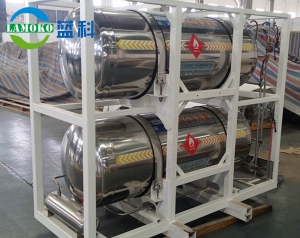

Contacts:Mr. Pan
Mobile:13390831768
Landline:0512-82592088
Fax:0512-82592078
Mailbox:phj@lamoko.com
Address:No. 36 Renmin Middle Road,Zhangjiagang
Website:m.zgcdj.com.en
Principles of safe transportation of LNG cylinders
1. vehicles must be safe and reliable. Compared with the common metal cylinder pusher, there is no friction spark in the process of transportation, no corrosion, no noise, no maintenance. In addition, the full molded cylinder pusher has stronger pushing function, better balance and better operability than the metal cylinder. Lightweight, effortless and durable. It can be applied to any road surface, and the diameter of the cylinders can be up to 31 centimeters.
2. must wear good cap (with protective cover cylinder, shockproof ring (except) container cylinders except), light light unloading, throwing, sliding, rolling, no touch.
3. when lifting, it is forbidden to use electromagnetic crane and metal chain rope.
4. gas bottle contact can cause burning and explosion, poison gas, may not be the same car (car) transport; flammable, flammable, corrosive materials or gas in the chemical reaction of the goods, shall not be transported together with gas cylinders.

5. when the vehicle is transported, the gas cylinder should be properly fixed. When standing down, the height of the carriage should be above 2/3 of the bottle height. When lying horizontally, the end of the bottle valve should be facing one side, and the stack height should not exceed five layers and shall not exceed the height of the carriage.
6. summer transportation should have sunshade facilities, avoid insolation; in the busy areas of the city should avoid transportation during the day.
7. when transporting flammable gas cylinders, no fireworks are allowed. Fire extinguishers should be provided on transport vehicles.
8. transport cylinders of the vehicle and ship docked in the downtown area, not near the crowded schools, theaters, shops and other large vehicles and ships docked; when driving and escort personnel shall not leave at the same time.
9. cylinders equipped with liquefied petroleum gas are forbidden to transport more than 50 kilometers.
10. gas cylinders should be strictly transported in accordance with the provisions of dangerous goods transport regulations.
11. transport enterprises should formulate emergency measures, drivers and guards should be handled correctly.